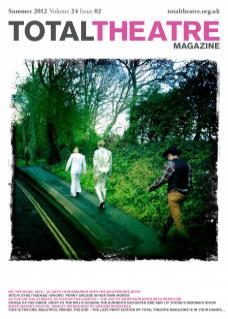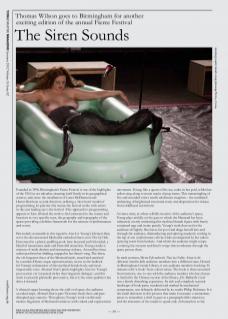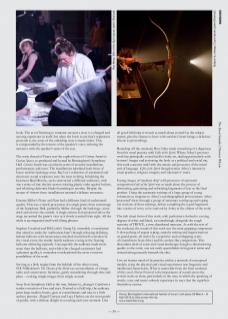Founded in 1998, Birmingham’s Fierce Festival is one of the highlights of the UK live art calendar, situating itself firmly in its geographical context, and, since the installation of Laura McDermott and Harun Morrison as joint directors, utilising a ‘slow burn’ model of programming. In practice this means the festival works with artists in the year leading up to the festival. This approach to programming appears to have allowed the work to feel connected to the venues and locations in very specific ways, the geography and topography of the spaces providing a definite framework for the mixture of performances and events.
Particularly noticeable in this regard is Ann Liv Young’s Mermaid Show, set in the deconsecrated Methodist cathedral that is now The Q Club. Ensconced in a plastic paddling pool, bare-breasted and fish-tailed, a blend of renaissance nude and Seaworld attraction, Young exudes a mixture of snide disdain and simmering violence. Around her three sailors perform her bidding, trapped in her Siren’s song. The Siren, the oft-forgotten facet of the Mermaid myth, erased and sanitised by countless Disney-esque representations, serves as the bedrock for Young’s reclamation of this mythical female body, and more importantly voice. Mermaid Show’s précis highlights Ann Liv Young’s provocation via ‘corporeal rather than linguistic dialogue’, and this work is certainly physically provocative, but it is the sonic qualities that drive it forward.
A silenced organ looming above the cold oval space, the audience on raked steps, Mermaid Show is part Victorian freak-show and part-disrupted pop-oratorio. Throughout, Young’s work vociferously meshes fragments of Mermaid narratives with violent and expressionist movement. Young, like a queen of the sea, soaks in her pool, whilst her sailors sing along to iconic tracks of pop-sirens. This intermingling of live and recorded voices recalls adolescent escapism – the combined embracing of heightened emotional states and desperation for release from childhood restrictions.
At times witty, at others wilfully invasive of the audience’s space, Young plays artfully on the gaze to which the Mermaid has been subjected, overtly reclaiming this mythical female figure with barely contained rage and ironic parody. Young’s work does not let the audience off lightly. She leaves her pool and drags herself into and through the audience, dismembering and spitting mackerel, settling in the lap of one (un)fortunate; all the while accompanied by her sailors spraying water from buckets. And whilst the audience might escape a soaking the screams and Siren’s songs that reverberate through the space pursue them.
In stark contrast, Mette Edvardsen’s Time has Fallen Asleep in the Afternoon Sunshine lulls audience members into a different state. Hosted in Birmingham Central Library, it saw audience members booking 30 minutes with ‘a book’ from a short menu. The book is then recounted from memory, one-to-one with the audience member who has chosen it. Settled in the Chinese section of the library, J.G. Ballard’s Crash was a faintly disturbing experience. Its rich and complexly textural landscape of body parts, sundered and marked by mechanical components, was delicately delivered by its reader Philip Holyman. It is the small decisions in this process that make it resonate: a momentary pause to remember, a shift in gaze as a paragraph shifts trajectory, and the insistence of the reader to speak only of themselves as the book. The act of listening to someone recount a story is a charged and moving experience in itself, but when the book is one that’s reputation proceeds it, the sense of the unfolding story is made richer. This is compounded by the texture of the speaker’s voice, imbuing the narrative with the speaker’s sense of the text.
The sonic thread of Fierce was the explicit focus of Curious Sounds in Curious Spaces, co-produced and hosted by Birmingham’s Symphony Hall. Curious Sounds was an eclectic series of acoustic installations, performances and tours. The installations inhabited both front of house and the backstage areas. Ray Lee’s collection of automated and electronic sound sculptures were the most striking. Inhabiting the basement Band Rooms, each constructed a different ambience, with one a series of tiny electric motors rotating plastic stubs against lockers, and whirring electronic blades humming in another. Despite the stream of visitors these installations retained a delicate resonance.
Graeme Miller’s Picture and Piano had a different kind of understated quality. This was a stately procession of a single piano from centrestage of the Symphony Hall, pushed by Miller, through the backstage, scene dock and on into the outside. A single camera feed projected above the stage recounted the piano’s view as it slowly receded from sight. All the while it accompanied itself with lilting phrases.
Stephen Cornford and Bill Leslie’s Tuning Up, ostensibly a sound piece that aimed to make the ‘auditorium hum’ through releasing deflating helium balloons with harmonicas attached, found itself overtaken by the visual event, the mainly family audience cooing at the floating balloons skittering upwards. Consequently the audience made more noise than the balloons, and whilst this charged excitement had a pleasant quality, it somewhat overshadowed the more evocative possibilities of the work.
Serving as a little respite from the hubbub of the other events, SOUNDkitchen’s The Theatre of the Mind was an installation of vintage radio and conservatory furniture, gently meandering through time and place – evoking simple images from simple sounds.
Away from Symphony Hall at the mac, Subject to_change’s Cupid was a tender evocation of love and stars. Framed as a field trip, the audience paint large modroc hearts, gaze at constellations and take in a little archery practice. Abigail Conway and Lucy Hayhoe are the most gentle of guides, with a delicate delight in revealing each new moment. Like all good field trips it reveals as much about yourself as the subject matter, plus the chance to leave with another’s heart brings a delicious frisson to proceedings.
Rounding off the weekend, Ron Athey made something of a departure from his usual practice with Gifts of the Spirit. Where Athey’s previous work has principally rooted itself in body art, dealing particularly with ‘extreme’ images and activating the body as a political and social site, this work concerns itself with the nature and processes of the mind and of language. Gifts of the Spirit though retains Athey’s interest in ritual practice, religious imagery and ‘alternative’ states.
Fusing images of ‘medium-ship’ with processes of automatic composition Gifts of the Spirit was as much about the process of abstracting, generating and reforming fragments of text as the final product. Using the automatic writings of a large group of young volunteers in response to Athey’s autobiographical provocations, Athey ‘processed’ these through a group of assistants cutting-up and typing out sections of these writings, before compiling the typed fragments into a series of texts, to be read out by Athey at the climax of the work.
The rich ritual form of this work, with performers clothed to varying degrees of white and black, sat tantalisingly alongside the rough austerity of TROVE, a now abandoned museum. As with the rest of the weekend, the sound of this work was the most gripping component. A slow pulsing of urgent typing, scratchy writing and improvisations on grand piano, all tied in by a repetitive and overlapping series of countdowns from Athey and his acolyte-like companions. This discordant clash of sonic and visual landscapes bought a disorientating quality to the event, one not easily quantifiable in linguistic terms and instead sitting uneasily beneath the skin.
Live art frames much of its practice within a network of conceptual models, tying the physical and visual experiences into linguistic and intellectual frameworks. What is noticeable from the final weekend of this year’s Fierce Festival is the importance of sound across the artistic work on show, particularly in the ways in which the speaking of words, voice and music embody experience in ways that the signifiers themselves cannot.
Fierce, Birmingham’s international festival of live art, took place 29 March – 8 April 2012 at sites across the city. www.wearefierce.org


